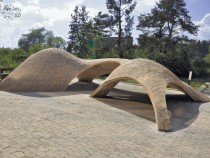
© Klemen Breitfuss
Constructing vaults in brick was mastered by the Romans, but it evolved as time passed. The Catalan vaulting technique in particular made it possible to build spectacular structures, with designs by, for example, Antoni Gaudí or Rafael Guastavino, and was employed in a wide range of applications during the first half of the twentieth century, at which time it was replaced by new methods of construction and modern building materials such as concrete and steel. Now there are signs that interest in this technique for contemporary architecture is growing, and through new applications it is making a comeback in practice and research. The technique is structurally highly efficient, based on materials from natural sources, and does not require elaborate falsework. These characteristics, in combination with the geometric flexibility of the construction system, have great potential for shell structures, which typically have been realised in concrete and steel. In many respects, Catalan vaulting is in the lineage of the common brick vault of Roman times, but the bricks are not laid, as they had typically been, in an upright position, but employed flat, usually in three layers. Through this successive assembly of lightweight layers of bricks, and by using fast-setting gypsum mortar, the first layer can be erected without a falsework structure. ?(Philippe Block, Matthias Rippmann)















